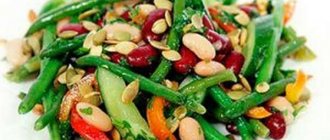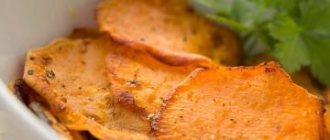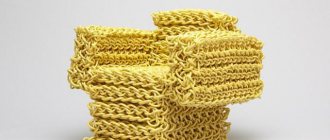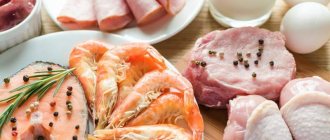Chips first appeared in the middle of the 19th century and very quickly won the love of all segments of the population in many countries, and the oldest brand of the product that still exists today is the Lays brand. Over more than a century and a half of history, the product has not undergone major changes in the method of preparation - it is still very thin slices of potatoes fried in a large amount of oil. But new, sometimes very non-standard, flavor combinations are released almost every month. Over time, not only potato and corn chips gained popularity, but also healthier ones - apple, banana, orange, etc. In this article we will talk about the calorie content of different types of chips.
Composition and calorie content of chips
Most varieties of this popular delicacy are based on potatoes. This vegetable is quite healthy. The finished product itself includes many substances needed by the body. But this applies only to natural, unsalted potato chips without foreign additives.
According to BZHU indicators, finished products have a rather meager energy value (per 100 g):
- Proteins – 5.5 g;
- Fats – 30.0 g;
- Carbohydrates – 53.0 g.
Calorie content is about 520 kcal per 100 g. Nutritional value is supported by the presence of nutrients, including vitamins: C, E, K, PP, group B, as well as essential minerals:
Macroelements (mg/100 g):
- Magnesium – 67;
- Potassium – 1275;
- Sodium – 8;
- Phosphorus – 165;
- Calcium – 24.

Microelements:
- Copper – 306 mcg;
- Zinc – 1.09 mg;
- Manganese – 0.44 mg;
- Selenium – 8.1 mcg;
- Iron – 1.63.
The presence of non-essential and essential fatty acids is also observed. The glycemic index of potato chips is 85 and has a 1 point on a 5-point food hazard rating scale, so it is strictly prohibited for people with diabetes to consume them.
Chips in two minutes
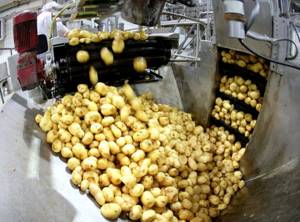
Photo: DPA/Rolf Vennenbernd
Chips are also made using a new technology: these are potato slices that are fried very quickly, almost more than two minutes - this is a gentle technology. It is believed that these are the highest quality chips. They cost many times more.
“Perhaps they are less harmful, but still, sodium gluconate is added to them. And, despite the fact that such chips are considered to be of better quality, they are not a dietary product, because the glycemic index of potatoes will be only slightly lower than that of starch chips. But these are, perhaps, the only chips that can be eaten - in small quantities and extremely rarely, provided that at other times the person eats properly. By the way, hypertensive patients, people suffering from vascular diseases and diseases of the gastrointestinal tract should forget about chips forever. There is nothing good in this product,” the nutritionist concluded.
Types of chips
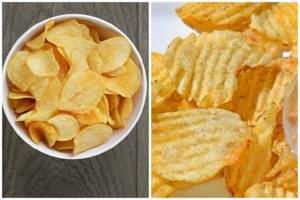
Modern chips are no longer similar to their predecessors, for the production of which only potatoes, salt and oil were used. Today, manufacturers include many foreign substances in their composition, and the high demand for products makes it possible to reduce the cost and speed up production. That is why such crispy slices do not bring any benefits to human health and in no way fit into the concept of a healthy diet.
Stores offer the following types of products:
- Crispy potatoes - the tubers are thinly sliced and fried in a small amount of oil with the addition of just salt. The products are closest to the classic original recipe and practically do not contain preservatives. Such slices quickly deteriorate due to their short shelf life, do not look very appetizing, do not hold their shape and break;
- Potato chips and snacks are made from specialized varieties of potatoes with a large amount of starch. They have a round or rectangular shape, sometimes they are corrugated. In most cases, they contain various preservatives, flavor enhancers, flavorings and sealants that extend shelf life and increase the strength of products;
- Molded chips - made in the form of plates from pressed mashed potatoes in combination with corn or potato starch, flour and flavor enhancers. They are also called potato waffles or savory cookies.
Composition of the product
Modern snacks practically do not contain natural potatoes. It is replaced by corn and wheat flour, and sometimes by starch, which is genetically modified. In addition, to give the necessary taste, a large number of harmful chemical compounds are added to the product.
Thus, the composition of store-bought chips may include:
- wheat flour;
- mixed vegetable oil;
- corn starch;
- sugar;
- flavoring additives identical to natural ones;
- flavor and aroma enhancer;
- salt.
What do modern chips include?

Currently, there is practically nothing left of the old original recipe. The composition of ready-made snacks additionally includes many harmful components. Here are the main ones:
- Modified potato starch is produced industrially and leads to certain disorders in the body due to changes in the level of inulin, a carbohydrate responsible for regulating blood sugar;
- Unrefined oils – low-quality raw materials are often used several times for frying. This directly affects the finished product;
- Corn starch is not a harmful component in itself, but causes severe allergic reactions in some people;
- Palm oil is used in production by unscrupulous manufacturers because of its low cost. Palmitic acid, which is part of it, has a very detrimental effect on the functioning of blood vessels and the heart;
- Preservatives - many of these components are included in the group of toxic phenols and sulfites. This significantly increases the risk of disease from consuming the product;
- Flavor enhancers and flavorings – this includes the well-known monosodium glutamate. Most of these substances are considered safe, but can still cause allergies and be irritating. If there is an excess of them in the body, the following may occur: headache, arrhythmia, nausea.
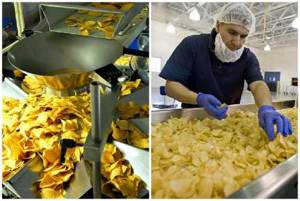
Often, fried crispy slices contain various thickeners that can pose health risks, so you should carefully read the packaging when purchasing the product.
TOP 5 “healthy” foods that are actually very high in calories
When trying to lose weight, people often look for dietary substitutes for their usual foods. But if you don't understand calories, you can gain even more calories than if you ate a pack of chips or a burger.
5-tv.ru tells us which PP products are not actually dietary.
Dates
Nutritionists and healthy lifestyle bloggers often advise replacing sweets with dates. Yes, they contain many useful microelements: 23 types of amino acids, nicotinic acid and riboflavin.
Dates are also rich in calcium and fiber. But in terms of the amount of carbohydrates, they are ahead of even bananas, because 100 grams contain 75 grams of carbohydrates.
Agree that it was not for nothing that the Bedouins took dates with them to the desert to maintain energy.
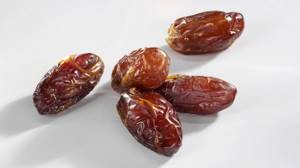
The calorie content of one date is 25 calories, and one package from the supermarket can reach over 400 calories. Globallookpress.com / Karl Newedel
The calorie content of one date is 25 calories. If you eat at least ten pieces, you will already gain 250 calories. A larger amount can beat even chocolate in terms of calorie content. For example, the calorie content of a milk chocolate bar usually does not exceed 530 calories per 100 grams, and the carbohydrate content is 60 grams.
PP ice cream
Often people who watch their diet and figure prefer to make ice cream from fruits and berries rather than eat the usual cone. But healthy lifestyle ice cream is much higher in calories than dairy ice cream.
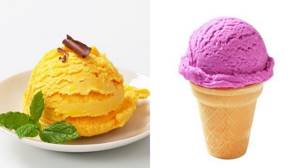
Homemade popsicles are much higher in calories than their regular store-bought cup. 5-tv.ru, Globallookpress.com / Digifoodstock.com

What seasonal vegetables and fruits should I buy in May?
Healthy ice cream is usually made from bananas—one fruit contains 95 calories and 21 grams of carbohydrates. Berries are also added, such as strawberries or blueberries. Together with them, a couple of bananas provide about 200 calories. But regular ice cream in a waffle cone has an energy value of about 180 kcal and 20 grams of carbohydrates.
Olive oil
Olive oil itself is very healthy and it is better to dress salads with it than with sunflower oil, but the calorie content of the product is quite high. One tablespoon of olive oil (25-30 grams) contains about 180 calories. Vegetable salad becomes not so dietary.
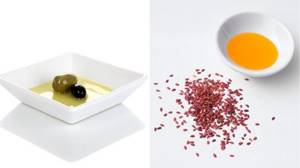
Nutritionists advise replacing olive oil with flaxseed oil. Although it is not inferior in calorie content, it promotes weight loss and removes toxins from the liver. 5-tv.ru, Globallookpress.com / Imagebroker / Ralph Kerpa, Globallookpress.com / Pfeiffer, J.
Of course, you can’t live without oils, but it’s better to replace olive oil with flaxseed oil. True, it is not inferior in calorie content, but contains fewer different groups of fats and nutritionists recommend consuming it while losing weight. Flaxseed oil helps detoxify the liver and is rich in Omega-3.
Dark chocolate
Dark chocolate bars are much healthier than milk chocolate bars due to their low sugar content and high cocoa percentage. But be very careful when choosing a manufacturer.
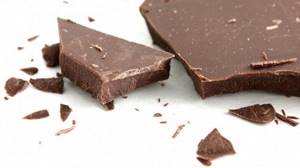
Check the ingredients of your dark chocolate and avoid brands that add large amounts of sugar. TASS / YAY
Some factories add a lot of sugar to dark chocolate, as a result of which it loses its benefits. Some bars can reach 700 calories per 100 grams. Carefully study the composition before purchasing.
Granola
Even from its composition, it is clear that the traditional American breakfast cereal has nothing in common with dietary products. However, there are many granola recipes on Instagram. It contains fiber, and some believe that granola “cleanses the stomach.”
The harm and benefits of chips
When making crispy slices, frying starch produces many hazardous substances, especially if low-quality oil is used. Here are just a few of them:
- Acrylamide - appears when sugars interact during frying. Very toxic and harmful to the kidneys, nervous system, mucous membranes of the eyes and liver;
- Acrolein - occurs during the decomposition of fats during heat treatment. Known for strong toxic and irritant properties. To avoid its excessive formation, it is necessary to frequently change the deep fat for frying, but many manufacturers regularly neglect this;
- Glycidamide - appears from the partial breakdown of acrylamide. This substance has not yet been fully studied, but its carcinogenic properties have already been proven.
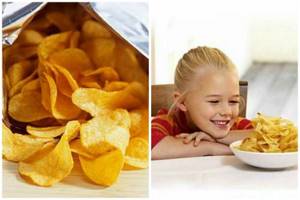
Various chemical compounds and components formed during the production of snacks can cause the following harm to the human body:
- Increased risk of diabetes;
- The likelihood of oncological diseases and the occurrence of tumors;
- Increased blood cholesterol levels, which can subsequently lead to disruption of the brain and heart due to blockage of blood vessels;
- Obesity and metabolic disorders;
- Decreased testosterone and decreased reproductive function in men;
- Dysfunction of the gastrointestinal tract.

These consequences can only be avoided by completely eliminating chips from the diet or reducing their consumption to an absolute minimum.
The body can only benefit from a natural product, prepared independently without foreign additives.
Main conclusions
Store-bought potato chips and dieting don't mix. As an alternative, you can try fruit and vegetable snacks that can easily be prepared at home:
- Potato snacks are not only high in calories, but also full of harmful substances.
- Their regular and especially excessive consumption can lead to obesity, atherosclerosis, allergies and even diabetes, and for those who already suffer from these diseases, chips can cause an exacerbation of the disease.
- You can prepare healthy snacks at home.
- Any vegetables and fruits can be used as “raw materials”.
- Snacks can be baked in the oven or cooked in the microwave.
- You should not use salt, as it retains water in the body and dulls the taste of natural products.
Fruit and vegetable snacks are an ideal snack that will help fight hunger without compromising your figure.
Share your weight loss stories, favorite diets and diet chips recipes.
Recommendations for eating chips
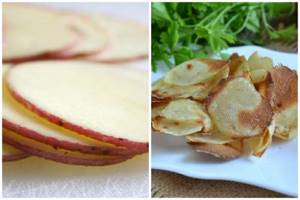
It is not recommended to eat crunchy treats if:
- Diseases of the intestines and stomach;
- Increased amount of cholesterol in the blood;
- Diabetes mellitus;
- Metabolic problems and obesity;
- Suspicion of oncology;
- Up to 12 years of age.
In order for snacks to be better absorbed, they should be eaten together with fresh vegetables. The classic tandem of beer and chips is categorically incompatible with a healthy lifestyle.
How to cook
Peel 400g of potatoes (it is not necessary to peel young ones) and cut into thin slices (2 mm). Rinse and place on a paper towel, cover with another to dry.
If cooking in the oven, place parchment paper on a baking sheet and grease with olive oil. If in the microwave, do the same with the plate. Place the potatoes on paper, sprinkle with salt, pepper or other spices to taste and set to bake. As soon as the top of the slices turns brown, you need to remove them.
Other types of chips are prepared in the same way.
Tips for choosing chips

There are simply no ways to minimize the risk of frequent consumption of potato slices. However, choosing quality products will help reduce harm to health. To do this, pay attention to the following recommendations:
- If on the front side of the package there is the inscription “From natural potatoes”, and the composition contains only potato starch, then put this pack aside and move on. The same should be done if the composition contains many unfamiliar chemical substances;
- Conscientious manufacturers always indicate the chemical name of the additive and its international labeling;
- The longer the shelf life of the product, the more preservatives it contains. A minimal amount of them is contained in crispy potatoes;
- A low price is a signal that cheap raw materials may have been used to produce the product. Although high cost is also not always an indicator of quality. Therefore, it is best to give preference to well-known “folk” brands.
If you can completely eliminate chips from your menu, that’s just great. If you still want to treat yourself to a crunchy delicacy, then you should choose high-quality, expensive products. But the best option would be to switch to less tasty but healthier foods.
How many calories are in a packet of chips?
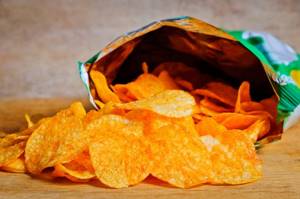
Most often, potato chips attract the attention of buyers. Thin slices of potatoes are fried in a huge amount of oil. They become crispy, golden and incredibly tasty. But are they really useful and safe? And in general, what is their calorie content? Generally speaking, the nutritional value of a 100-gram serving of chips is 500 kilocalories. The indicator is huge, since for many people this is a third of the daily diet.
The calorie content of a crispy treat at home may differ slightly, because you can prepare chips without oil, but simply dry the potato slices in the oven.
How many calories are in Lay's chips? Their nutritional value will vary from 500 to 527 kilocalories per 100 grams of product. It all depends on what nutritional supplements were used. Thus, the product of this brand with bacon, cheese, sour cream and crab meat has the lowest calorie content compared to other chips. But onion chips will be a little higher in calories.
On a note! When producing chips on an industrial scale, various flavoring components, dyes and other not entirely healthy ingredients are used to improve the taste.
But chips are not only made from potatoes. Today, many supporters of a healthy diet choose banana pulp for making chips, even at home.
How many calories are in banana chips? If fresh bananas are not very high in calories, then after drying their nutritional value increases several times.
A 100-gram serving of banana chips contains about 517 kilocalories.
How many calories are in corn chips? These chips can be called the healthiest compared to other products from this line, but their nutritional value is not much different. The calorie content of corn crunchy treats is about 498 kilocalories per hundred grams. As you understand, you can’t treat yourself to these treats often.
Chips contain a huge amount of carbohydrates and fats. On the one hand, the product is incredibly tasty and you can take it with you on the road, since it will not spoil quickly, but on the other hand, it is extremely high in calories and a health hazard.
Why are chips dangerous?
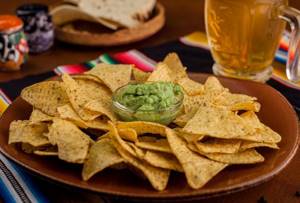
Chips lovers are skeptical about all the doctors' warnings. In fact, this product is really dangerous if you eat it systematically in unlimited quantities. When chips are fried, carcinogens are formed, which can even provoke the appearance of malignant tumors.
Being overweight after eating a high-calorie product is not the worst thing. But just imagine: on average, a person’s daily diet varies between 1500-2000 kilocalories. If we eat just 100 grams of chips, then we immediately destroy a third or fourth of our daily diet. And the feeling of fullness does not last long.
Eating this crunchy snack can cause the development of diseases of the digestive tract. Chips also have a negative effect on the thyroid gland. Studies have shown that lovers of such products are more likely to suffer from diabetes.
Representatives of the stronger half of humanity should limit their consumption of chips. If you regularly crunch on potato slices, you will soon notice a decrease in potency. The concentration of testosterone also decreases, resulting in impaired reproductive function.
Healthy chips
If you cannot deny yourself gastronomic pleasure, try making chips at home. In fact, potatoes contain many nutrients, micro- and macroelements, vitamins, and mineral compounds.
Only during the industrial production of a product under the influence of high temperature are they all destroyed. But at home you can make healthy chips. However, you shouldn’t abuse them either, and for the same reason.
It will be possible to reduce calories, but only slightly.
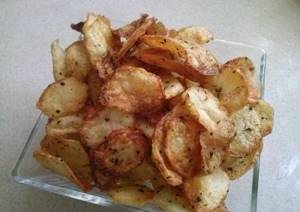
Ingredients:
- potatoes - several tubers;
- refined vegetable oil – 750-1000 ml;
- dried basil;
- salt;
- ground allspice.
Preparation:
- Peel the potato tubers and wash them thoroughly.
- Dry each potato with a napkin and cut into slices. Each slice should be as thin as possible, otherwise the chips will not turn out crispy and the dish will resemble fried potatoes.
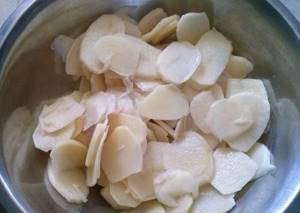
- Pour refined, odorless vegetable oil into a multi-cooker container.
- We activate the “Multi-cook” program mode. We set the temperature at 200-220°.

- First salt the potato slices.
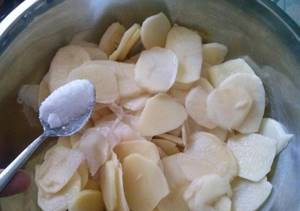
- Next, add dried basil. You can also use other dried herbs. A mixture of Provençal or Italian herbs is suitable.

- Add ground allspice.

- Mix everything well and leave for a few minutes to soak.
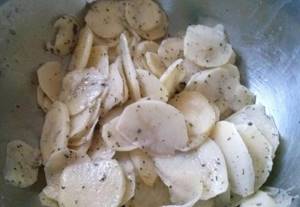
- Next, transfer the potato slices to a special mesh tray. It can come with the multicooker or you can purchase it separately.

- Meanwhile, the oil had already reached the boiling point and began to boil.
- Dip the potato slices into it and cover the multicooker with a lid.
- Cook for about a quarter of an hour. Be guided by the degree of roasting of the tubers.
- Place potato chips on paper towels and leave to cool completely.
- Now you can enjoy the amazing taste of this crispy treat. As you can see, no preservatives, dyes or flavor enhancers. Only natural ingredients.
Occasionally you can treat yourself to such a treat, but including chips in your everyday diet is dangerous for your health. You can prepare them at home with different flavors - sour cream, cheese, etc. It is better to give preference to homemade chips rather than store-bought products. Bon appetit and be healthy!
The article belongs to the site mnogoli.ru When copying, an active, indexed link to the source is required.
The history of potato chips
The appearance of chips was preceded by a story that took place in one of the hotel restaurants in New York state in the 19th century. According to legend, the chef of the restaurant was George Crum. When a famous millionaire dined at the restaurant, Crum was in high spirits. America's Railroad King, Vanderbilt returned two portions of potatoes to the kitchen with a comment about the slices being too thick, and the chef decided to teach the owner a lesson. He sliced the potatoes as thinly as the kitchen equipment of the time would allow and fried them until crisp.
The millionaire liked the dish for its taste, and he ordered it every time he had dinner throughout his business trip. A few months later, the dish became a signature item on the restaurant menu.
Later, Crum opened his own establishment, where he prepared chips - thin, deep-fried slices with unique taste properties, according to his own recipe.
The end of the 19th century saw the emergence of the production of take-out chips; they came up with the idea of using edible wax paper for packaging.
In 1932, Herman Ley began selling chips in small quantities, and the company later acquired a name that is recognizable to this day. During the existence of the company, it merged with the famous Pepsi corporation: since then, chips and carbonated water have become inseparable.
Useful tips
The harm of store-bought potato chips is obvious: they differ completely in their chemical composition. It is impossible to lose excess weight by eating such food. Therefore, dietary options for chips come to the rescue, the quality of which you can be sure of, because you prepared them at home yourself. To make the dish even healthier and tastier, take into account the recommendations of nutrition professionals:
- The thickness of the slices should not exceed 2-4 mm. The higher this value, the longer the appetizer will take to cook.
- You will need olive and vegetable oil to slightly grease the baking sheet, so you don’t need to pour it over future chips.
- You can determine the readiness of snacks by their curved edges.
- The finished product must be transferred to a napkin to remove excess moisture.
For low-calorie PP chips, nutritionists advise choosing vegetables, fruits and low-fat meat. In popular recipes, the composition of snacks is limited only to the base and spices.
If you eat a jar of full-fat sour cream with homemade chips, you will not be able to lose kilos. And you certainly shouldn’t hope for a miracle of weight loss if diet chips act as a snack for beer. You can complement the taste of unsweetened snacks with natural yogurt, balsamic vinegar or cream, pesto sauce. Sweet options go well with tea and replace candy.
Snack calorie table
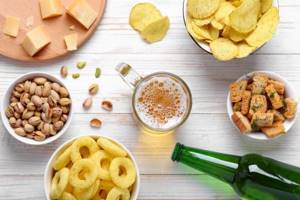
© lenakorzh — stock.adobe.com
Share:
It’s not always possible to eat right, especially when there is so much “temptation” around in the form of a variety of different snacks. They are far from the healthiest foods to include in your diet. Due to the high content of sugars and fats, snacks have a negative effect on the human body. That is why many nutritionists advise to completely abandon them. However, if something has already happened that you incredibly want snacks, do not give up your desire. However, do not forget to count calories. A table of caloric content of snacks will help you with this, which also includes the content of proteins, fats and carbohydrates.
| The product's name | Calorie content, kcal | Proteins, g per 100 g | Fats, g per 100 g | Carbohydrates, g per 100 g |
| “Barentsev” Anchovy, salted and dried | 259 | 49,0 | 7,0 | 0,0 |
| "Barentsev" Squid rings | 242 | 53,0 | 2,0 | 3,0 |
| "Barentsev" Smoked squid | 242 | 53,0 | 2,0 | 3,0 |
| "Barentsev" Squid, salted and dried | 286 | 62,0 | 2,0 | 5,0 |
| “Barentsev” Shrimp with spices | 192 | 36,0 | 4,0 | 3,0 |
| "Barentsev" Okinel fillet slices | 280 | 50,7 | 8,6 | 0,0 |
| "Barentsev" Okinel with pepper | 280 | 50,7 | 8,6 | 0,0 |
| "Barentsev" Original fish straws | 231 | 46,0 | 3,0 | 5,0 |
| “Barentsev” Smoked fish strips | 231 | 46,0 | 3,0 | 5,0 |
| "Barentsev" Somul salted and dried | 274 | 65,8 | 1,2 | 0,0 |
| "Barentsev" Golden smoked horse mackerel | 264 | 48,0 | 8,0 | 0,0 |
| "Barentsev" Silver horse mackerel, salted and dried | 264 | 48,0 | 8,0 | 0,0 |
| "Barentsev" Salted and dried tuna | 234 | 57,8 | 0,3 | 0,0 |
| "Barentsev" Chicks fish with pepper | 280 | 50,7 | 8,6 | 0,0 |
| "Silver" Anchovy, salted and dried | 258 | 57,4 | 3,1 | 0,1 |
| "Silver" Yellow fish | 336 | 40,0 | 16,9 | 1,0 |
| "Silver" Yellow minke whale | 262 | 52,4 | 5,8 | 3,3 |
| “Silver” Smoked squid | 263 | 58,0 | 1,0 | 3,0 |
| "Silver" Dried squid | 263 | 58,0 | 1,0 | 3,0 |
| "Silver" Flounder | 275 | 57,9 | 2,0 | 3,0 |
| "Silver" Squid Rings | 241 | 45,0 | 1,0 | 13,0 |
| “Silver” Smoked squid rings | 241 | 45,0 | 1,0 | 13,0 |
| “Silver” Grilled shrimp | 150 | 42,0 | 0,5 | 2,0 |
| "Silver" Sole | 336 | 40,0 | 16,9 | 3,0 |
| "Silver" Dried octopus | 95 | 31,0 | 0,5 | 2,0 |
| "Silver" Stavridka | 262 | 52,4 | 5,8 | 3,3 |
| "Silver" Silver tuna | 200 | 46,3 | 8,8 | 0,0 |
| "Silver" Eel | 275 | 57,9 | 2,0 | 3,0 |
| "Silver" Amber fish | 336 | 40,0 | 16,9 | 1,0 |
| "Syrtseedy" smoked classic cheese | 413 | 46,4 | 24,0 | 0,0 |
| “Syrtseedy” smoked cheese with tomato flavor | 413 | 46,4 | 24,0 | 0,0 |
| “Syrtseedy” smoked cheese with garlic and dill flavor | 413 | 46,4 | 24,0 | 0,0 |
| “Steering wheel” Anchovy, salted and dried | 147 | 22,0 | 2,7 | 3,1 |
| "Rudder" Yellow striped whale | 228 | 46,0 | 4,0 | 2,0 |
| “Steering wheel” Goldfish in Shanghai style | 191 | 36,0 | 2,5 | 6,2 |
| “Steering wheel” Salted goldfish | 191 | 37,9 | 3,0 | 3,0 |
| “Shturval” Salted-dried squid | 177 | 40,0 | 0,5 | 3,0 |
| "Steering wheel" Kamchatka fiery ambassador | 200 | 46,3 | 1,0 | 8,8 |
| “Shturval” Kamchatka ambassador salted and dried | 200 | 46,3 | 1,0 | 8,8 |
| “Shturval” Smoked squid rings | 197 | 45,0 | 0,5 | 3,2 |
| “Steering wheel” Salted squid rings | 197 | 45,0 | 0,5 | 3,2 |
| “Steering wheel” Salted and dried smelt | 145 | 28,0 | 3,0 | 1,5 |
| “Shturval” Salted and dried fire shrimp | 181 | 42,0 | 0,5 | 2,0 |
| “Steering wheel” Peeled shrimp | 181 | 42,0 | 0,5 | 2,0 |
| "Steering wheel" Fire perch | 249 | 50,9 | 2,3 | 6,2 |
| “Steering wheel” Salted and dried perch | 249 | 50,9 | 2,3 | 6,2 |
| “Steering wheel” Salted and dried octopus | 137 | 31,0 | 0,5 | 2,0 |
| “Shturval” Smoked sunny perch | 180 | 37,9 | 1,2 | 3,0 |
| "Steering wheel" Silver horse mackerel | 131 | 30,7 | 5,0 | 5,0 |
| “Steering wheel” Salted and dried eel | 187 | 38,0 | 2,5 | 3,2 |
| “Steering wheel” Shanghai minke whale, salted and dried | 261 | 54,2 | 5,5 | 3,0 |
| "Steering wheel" Amber fish | 98 | 20,0 | 1,8 | 0,5 |
| "Steering wheel" Amber firefish | 98 | 20,0 | 1,8 | 0,5 |
| M&M MARS, KUDOS – whole grain bars with M&M's, milk chocolate | 415 | 3,78 | 11,95 | 70,61 |
| M&M MARS, KUDOS – whole grain bars with peanut butter | 463 | 5,88 | 20,78 | 62,09 |
| Banana chips | 519 | 2,3 | 33,6 | 50,7 |
| Bar with cereals and milk | 413 | 6,47 | 10,98 | 71,65 |
| Popcorn | 354 | 9,4 | 3,3 | 76,5 |
| Puffed wheat | 366 | 16,26 | 2,15 | 66,99 |
| Puffed rice | 349 | 6,2 | 0,3 | 85,7 |
| Biscuits | 393 | 9,7 | 10,2 | 65,6 |
| Biscuits made from premium flour | 393,5 | 9,7 | 10,2 | 70,1 |
| Biscuits made from first grade flour | 345 | 11 | 1,4 | 69,5 |
| Beef sticks, smoked | 550 | 21,5 | 49,6 | 5,4 |
| Chewing gum | 247 | 0 | 0,3 | 66,08 |
| Chewing gum (sugar-free) | 268 | 0 | 0,4 | 94,8 |
| Chewing gum (with sugar) | 247 | 0 | 0,3 | 66,08 |
| Potato sticks | 522 | 6,7 | 34,4 | 49,9 |
| Potato chips | 547 | 6,56 | 37,47 | 49,74 |
| BBQ flavored potato chips | 491 | 7,7 | 32,4 | 52,8 |
| Potato chips, from dry potatoes, low fat, with extra. olestra (synthetic fat replacer) | 253 | 5,06 | 0,93 | 48,7 |
| Potato chips, from dry potatoes, with cheese flavor | 551 | 7 | 37 | 47,2 |
| Potato chips, low fat, with extra. olestra (synthetic fat replacer) | 274 | 7,74 | 0,7 | 58,2 |
| Potato chips, low fat, with salt | 379 | 9,64 | 0,6 | 76,26 |
| Potato chips, regular, partially hydrogenated soybean oil, unsalted | 536 | 7 | 34,6 | 48,1 |
| Potato chips, regular, partially hydrogenated soybean oil, salted | 536 | 7 | 34,6 | 48,1 |
| Potato chips, regular, unsalted | 536 | 7 | 34,6 | 48,1 |
| Potato chips, regular, salted | 532 | 6,39 | 33,98 | 50,73 |
| Potato chips, reduced fat, 20.8% | 471 | 7,1 | 20,8 | 61 |
| Potato chips, salted, reduced fat, 20.8% | 487 | 7,1 | 20,8 | 61,7 |
| Potato chips, sour cream and onion flavor | 531 | 8,1 | 33,9 | 46,3 |
| Potato chips, cheese flavor | 496 | 8,5 | 27,2 | 52,5 |
| Crackers | 502 | 7,4 | 25,3 | 61 |
| Crackers made from premium flour | 417,6 | 9,2 | 14,1 | 67,7 |
| Whole wheat crackers | 443 | 8,8 | 17,2 | 68,6 |
| Bran crackers | 416 | 9,2 | 14,1 | 63,2 |
| Pretzels | 380 | 10,34 | 2,63 | 79,76 |
| Pretzels, soft, unsalted | 345 | 8,2 | 3,1 | 69,34 |
| Corn sticks | 518 | 6,03 | 28,41 | 57,71 |
| Corn sticks “Kuzya” | 496,6 | 4,3 | 24,2 | 65,4 |
| Sweet corn sticks | 467 | 4,7 | 13 | 82,9 |
| Corn puffs, uncooked | 224 | 8,36 | 0,92 | 6,64 |
| Cornflakes | 347 | 15,1 | 1,3 | 73,3 |
| Corn chips | 539 | 6,17 | 33,36 | 53,27 |
| Corn chips, unsalted | 557 | 6,6 | 33,4 | 53 |
| Corn chips, BBQ flavor | 523 | 7 | 32,7 | 51 |
| Corn chips, BBQ flavor, enriched flour | 523 | 7 | 32,7 | 56,2 |
| Corn balls | 354 | 6 | 12,1 | 68,8 |
| Soft pretzels | 338 | 8,2 | 3,1 | 69,39 |
| Skim sips | 379 | 9,64 | 0,6 | 83,76 |
| Popcorn | 407 | 7,3 | 13,5 | 62,7 |
| Popcorn without butter | 387 | 12,94 | 4,54 | 77,78 |
| White popcorn with butter | 500 | 9 | 28,1 | 57,2 |
| Caramel popcorn | 401 | 5,3 | 8,7 | 76,1 |
| Caramel popcorn, no nuts | 431 | 3,8 | 12,8 | 73,9 |
| Caramel Popcorn, Low Fat, 1.4% Fat | 381 | 2 | 1,4 | 87,56 |
| Popcorn with caramel and nuts | 400 | 6,4 | 7,8 | 76,9 |
| Popcorn with butter | 541 | 7,46 | 33 | 57,54 |
| Salted popcorn | 407 | 7,3 | 13,5 | 62,7 |
| Cheese popcorn | 506 | 5,8 | 30,8 | 50,1 |
| Popcorn, low fat, 9.5% fat, microwaved | 424 | 12,6 | 9,5 | 57,8 |
| Popcorn, low fat, 9.5% fat, low sodium, microwave | 429 | 12,6 | 9,5 | 59,19 |
| Hot air popcorn | 387 | 12,94 | 4,54 | 63,28 |
| Air popped white | 382 | 12 | 4,2 | 62,8 |
| Microwave Popcorn with Butter | 583 | 7,29 | 43,55 | 36,96 |
| Popcorn, popped with butter, unsalted | 500 | 9 | 28,1 | 48,1 |
| Popcorn popped with butter and salt | 500 | 9 | 28,1 | 47,2 |
| Microwave popcorn with palm oil | 535 | 8,38 | 30,22 | 47,26 |
| Plain corn chips | 518 | 6,03 | 28,41 | 63,01 |
| Wheat crackers | 473 | 8,6 | 20,6 | 64,9 |
| Wheat flakes | 337 | 12,3 | 1,4 | 73,5 |
| Rice and wheat bar | 409 | 9,09 | 9,09 | 70,93 |
| Soy chips | 385 | 26,5 | 7,35 | 49,65 |
| Soy chips, salted | 385 | 26,5 | 7,35 | 49,65 |
| Salty straw | 347 | 9,4 | 4,5 | 67 |
| Sweet straw | 372 | 9,1 | 6,1 | 69,3 |
| Crackers "Khrusteam" Baguette cheese platter | 445 | 10,5 | 15,7 | 66,0 |
| Croutons "Khrusteam" smoked sausage | 423 | 9,1 | 14,4 | 64,0 |
| Crackers "Hrusteam" wild mushrooms | 428 | 9,0 | 14,3 | 66,0 |
| Croutons "Hrusteam" salami | 425 | 8,5 | 12,0 | 69,0 |
| Crackers "Khrusteam" sour cream | 426 | 9,5 | 15,0 | 63,0 |
| Croutons "Hrusteam" cheese | 427 | 9,1 | 14,5 | 65,0 |
| Croutons "Khrusteam" grilled veal | 420 | 8,8 | 14,0 | 65,0 |
| Crackers "Hrusteam" tomato | 426 | 9,0 | 14,3 | 65,0 |
| Cheese crackers | 503 | 10,1 | 25,3 | 58,2 |
| Hard pretzels | 380 | 10,34 | 2,63 | 79,76 |
| Hard pretzels | 380 | 10,34 | 2,63 | 79,76 |
| Fruit chips | 350 | 3,2 | 0 | 78,1 |
| Crisp | 543 | 3,4 | 38,8 | 48,1 |
| Chips “Lays” Max sour cream and onion | 510 | 6,0 | 30,0 | 53,0 |
| Chips "Lays" Max sour cream and cheese | 510 | 6,5 | 30,0 | 53,0 |
| Chips "Estrella" rustic sour cream and onion | 514 | 5,2 | 30,9 | 53,9 |
| Chips "Estrella" fragrant dill | 517 | 5,2 | 31,2 | 53,7 |
| Chips “Estrella” soft cheese | 519 | 4,9 | 31,5 | 53,8 |
| Chips “Estrella” sour cream and soft cheese | 518 | 4,9 | 31,4 | 53,7 |
| Chips "Lays" bacon | 510 | 6,5 | 30,0 | 53,0 |
| Chips “Lays” porcini mushrooms with sour cream | 515 | 6,0 | 32,0 | 51,0 |
| Chips "Lays" green onions | 510 | 6,5 | 30,0 | 53,0 |
| Chips "Lays" crab | 510 | 6,5 | 30,0 | 53,0 |
| Chips “Lays” red caviar | 510 | 7,0 | 30,0 | 53,0 |
| Chips “Lays” lightly salted cucumbers with dill | 520 | 6,5 | 31,0 | 53,0 |
| Chips “Lays” sour cream and greens | 510 | 6,0 | 30,0 | 53,0 |
| Chips "Lays" cheese | 510 | 6,5 | 30,0 | 53,0 |
| Chips “Lays” kebab | 515 | 6,0 | 32,0 | 51,0 |
| Pringles BBQ chips | 550 | 4,9 | 35,0 | 48,0 |
| Pringles smoked bacon chips | 551 | 5,1 | 34,0 | 49,0 |
| Original Pringles chips | 540 | 4,1 | 36,0 | 49,0 |
| Pringles paprika chips | 529 | 3,2 | 34,0 | 49,0 |
| Pringles chips, sour cream and onion | 527 | 3,9 | 34,0 | 50,0 |
| Pringles chips cheese and onion | 550 | 4,1 | 34,0 | 50,0 |
| Pringles Cheese Cheese Chips | 534 | 5,0 | 35,0 | 48,0 |
| Sweet potato chips | 532 | 2,94 | 32,35 | 48,02 |
| Potato chips | 520 | 5,5 | 30 | 53 |
| Potato chips | 520 | 5,5 | 30,0 | 53,0 |
| Chocolate bar “POWER BAR” | 363 | 14,15 | 3,11 | 63,93 |
You can download the table so that you can always calculate your calories consumed right here.
Rate the material
Share:
